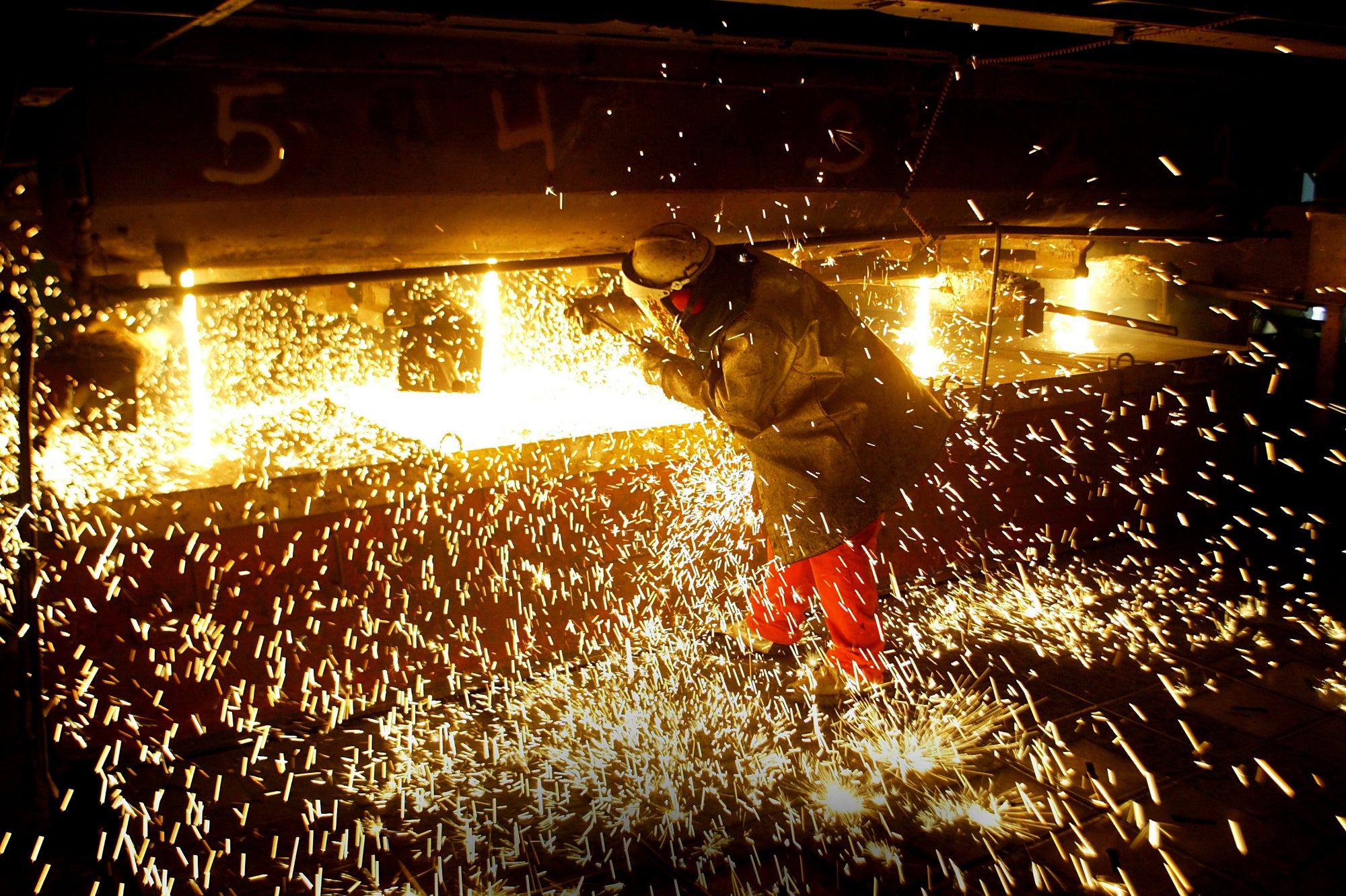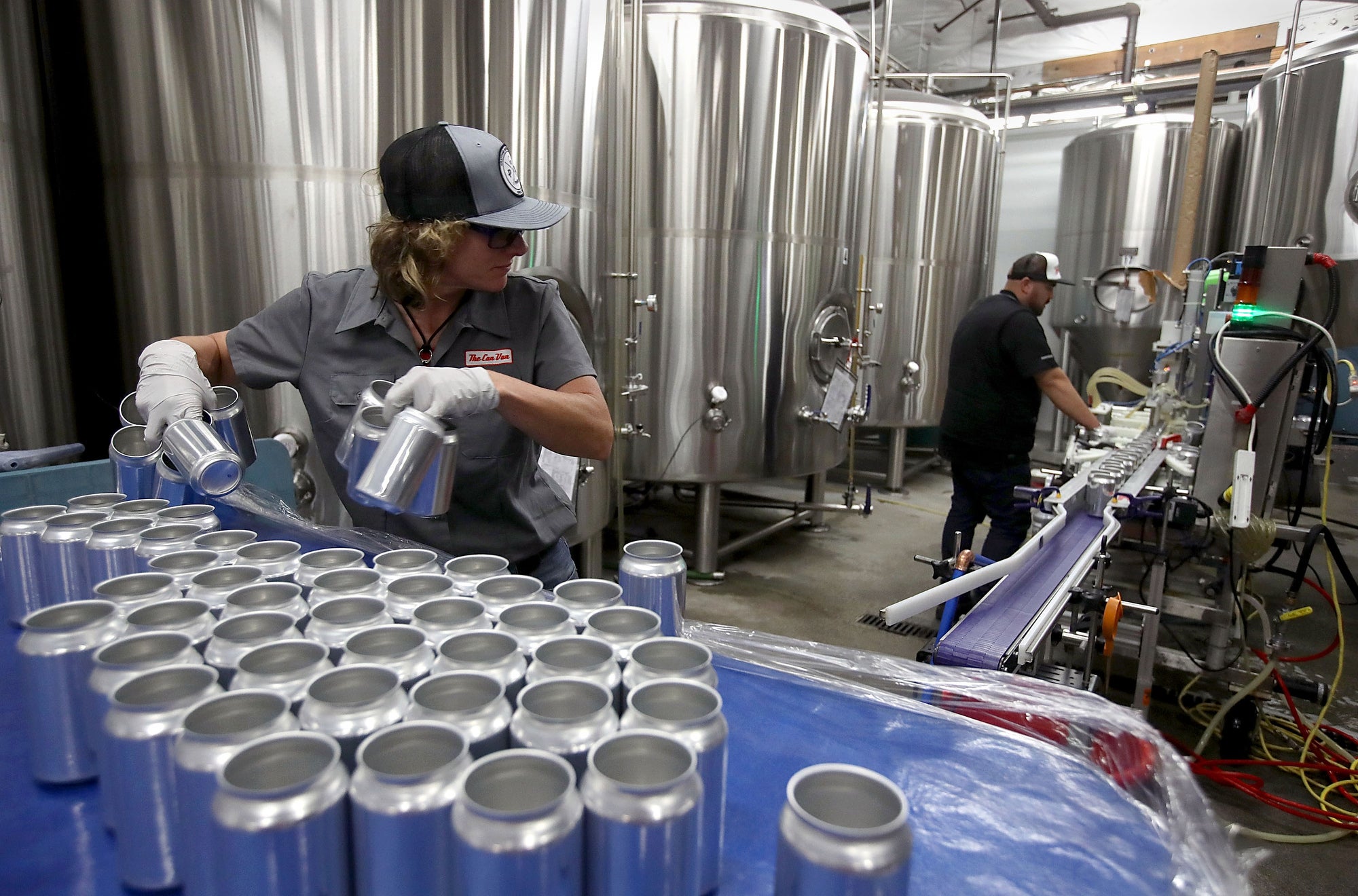From Ice Cream to Glass to Steel, California Needs to Think Big on Industrial Electrification
It’s time for the largest manufacturing hub in the country to develop a blueprint for zero emissions. Legislation like AB 2083 can get us there.
If you asked a random smattering of folks to name the largest manufacturing state in the country, I suspect you would hear a lot of folks say Michigan, Ohio, or Pennsylvania. I don’t think many would peg California as the nation’s largest manufacturing state, but it is. From food manufacturing to glass to cement, we have more manufacturing jobs in California than any other state in the country. This is something we should be proud of and zealously protect, but we should also look squarely at the downsides.

A worker in a steel mill checking the flow of molten steel before the casting process in Southern California. (Robert Lachman / Los Angeles Times via Getty Images)
These factories create good jobs and make important products, but they also pollute — a lot. Industrial emissions are roughly a quarter of all greenhouse gases produced in California. Our strategy to clean up factories to date has been to label them “hard to abate” or “hard to decarbonize” and do almost nothing. We use these terms to justify the lack of progress in the sector. It’s hard! We’ll get to it later?
We can’t afford that attitude any longer.
But there’s good news: The Biden administration has just announced $6 billion in funding for 33 industrial decarbonization projects in over 20 states. This avalanche of funding will jumpstart a transition to zero-emissions technology in some of our most energy-intensive industries, including the production of aluminum, steel, cement, and chemicals. These projects are projected to eliminate 14 million metric tons of CO2 emissions per year. The end result will not just help our climate, it will position American industry at the cutting edge of critical technologies. And, potentially no state in the country would benefit more from a transition to clean energy than California. Not only are we the number one manufacturing state in the country, many of the companies promoting solutions are based in California.
For example, Rondo Energy, a California company, recently received funding to decarbonize whiskey production in Kentucky by using thermal energy storage. As these clean industrial technologies expand spurred by the new infusion of federal dollars, California’s economy will benefit.
California is the food manufacturing hub of the country, but the LA region (which breathes some of the worst air quality in the nation) received no funding for projects in this sector from the DOE’s grants. California can and should lead in the shift to zero-emissions manufacturing. Numerous studies from the likes of Lawrence Berkeley National Laboratory, the Renewable Thermal Collaborative, and Global Efficiency Intelligence have all pointed to the technical and economic potential of industrial heat pumps, ovens, and other zero-emission equipment to clean up food manufacturing.

The downtown Los Angeles skyline bathed in smog. (Daniel Stein / Getty Images)
So where to start? With a plan to meet California’s goals. This year, Assemblymember Marc Berman introduced AB 2083, which directs the state to start creating that plan. As co-sponsors of the bill, we’re big fans. Electrification through heat pumps, thermal energy storage, and more can take us a long way towards cleaning up the sector. How far? That’s what we need to figure out, along with the workforce needs, the emissions benefits, and the infrastructure planning on the grid side to facilitate broad electrification.
The bill, an updated version of AB 841 introduced last year, directs the California Energy Commission to work with other agencies to look at these issues and draft an electrification roadmap. It creates the space to get the best minds together to make this the sector formerly known as “hard to decarbonize.” (For a deeper dive on the bill, read our fact sheet.)
Consider the food and beverage industry. California has more food manufacturing facilities than any other state. We’re world leaders in making not just food, but fun food: the mac and cheese with family, the beer and wine with friends on the weekend, the tortilla chips in your nachos. We make it all here in California. And today, that food production depends on methane gas — a lot of it. In Southern California, food manufacturing uses more methane gas than any industrial sector outside of the oil and chemical refineries.

An employee inspects tortilla chips as they are processed on a conveyor at the La Reina Tortilla factory in San Bernardino, California. (Watchara Phomicinda / MediaNews Group / The Press-Enterprise via Getty Images)
Regulators like the South Coast Air Quality Management District have even begun taking steps to transform the sector with a shift toward zero-emission equipment. More opportunities abound in other parts of industry (remember, “the industrial sector” is a catch-all term for a wide variety of distinct industries), like paper and pulp, glass manufacturing, and apparel. California companies are even building zero-emission technology to clean up cement production. But we need to do more, and we need to be smart about it.
The idea that we should start with a plan for our industrial sector may seem like a no-brainer. Who hates a plan (especially one that can help us secure more federal funding)? But the fossil fuel industry has planted the seed of a dangerous idea: that we can’t have specific venues and roadmaps for electrification.
We get it they’re scared. When folks realize that truly zero-emissions technologies — and not the overpriced and unproven unicorn climate strategies favored by fossil fuel companies — can take us far, they will start to realize that kicking our industrial sector combustion habits may be easier than we thought. Let’s not make the industrial sector a dumping ground for dubious technologies like carbon capture or biogas, questionable “solutions” we’ve fought so hard against in other areas like heavy-duty vehicles or power plants. Zero-emission strategies should sit at the center of any plan to clean up industry.

Beer is canned at a brewery in San Carlos, California. (Justin Sullivan / Getty Images)
After all, as critical as addressing climate change is, California also has a longstanding air quality crisis that sickens anyone who breathes on a daily basis. Even if it ever works on a large scale, Carbon Capture and Storage can’t fix this. These toxic emissions don’t harm Californians equally, either. An alarming 81% of NOx emissions from the food manufacturing industry are pumped out in communities already bearing the brunt of air pollution in the state. Likewise, 86% of NOx emissions from metals manufacturing are pumped out into overburdened communities, and 93% of NOx emissions from chemicals manufacturing come from facilities situated in overburdened communities. With clean energy technologies, we can clean the air in these communities as we reduce CO2 emissions, and there’s no reason not to do it.
The roadmap to a clean industrial sector created under AB 2083, by spurring innovation in our state, should also make it easier for California to get federal dollars for projects in all categories of future DOE funding. That will only strengthen California’s industrial sector, a key base for good jobs and economic opportunities.
Our state has faced many crossroads over its history, and once again, California is on the cusp of something significant. AB 2083 is the first bill of its kind anywhere in the country. An industrial electrification roadmap will serve not only Californians, but states across the U.S. that can emulate and build on California’s leadership. Next up for the bill is the Senate Appropriations Committee with a hearing this month and then, hopefully, the Senate floor. If you live in the Golden State, give your state senator a call and urge them to help pass AB 2083.
The California Regional Office fights for the rights of all to a healthy environment regardless of where in the state they live; we fight to protect the magnificent natural spaces and wildlife found in California; and we fight to transition California to a zero-emissions future where cars, trucks, buildings, and power plants run on clean energy, not fossil fuels.
